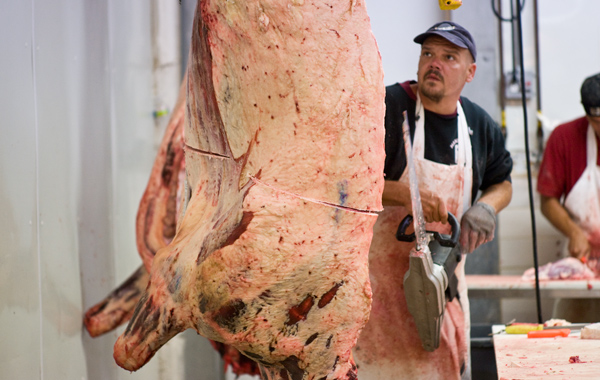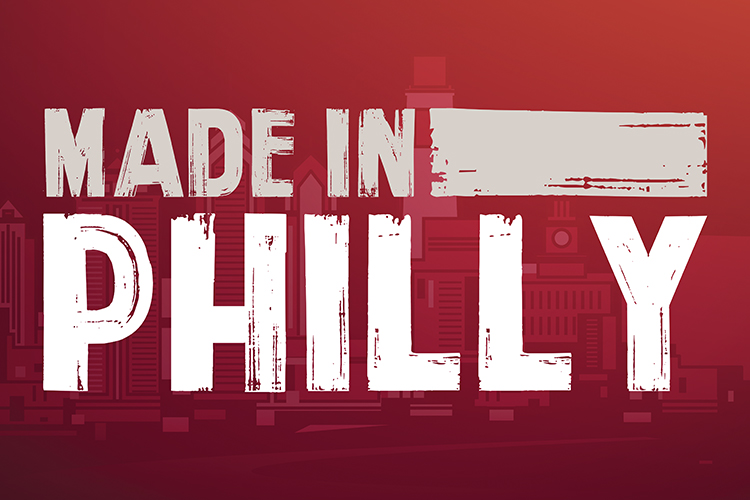 story by alaina mabaso | photos by albert yeeStanding next to meat hooks and the cage where bison, cows and pigs are fatally stunned in the first step of meat processing, Jay Smucker talks about his work. “We really enjoy what we do,” says the manager of the family-owned Smucker’s Meats, a slaughterhouse in Mount Joy, Pa. Smucker isn’t referring to the slaughter, but rather to the enjoyment of operating a small-scale, USDA-inspected facility that handles only seven animals per hour (big meat plants typically process around 1,000 pigs an hour). Smucker takes pride in providing a crucial service to link farmers and their consumers and, as he explains, “being good stewards of what we’ve been given.”
story by alaina mabaso | photos by albert yeeStanding next to meat hooks and the cage where bison, cows and pigs are fatally stunned in the first step of meat processing, Jay Smucker talks about his work. “We really enjoy what we do,” says the manager of the family-owned Smucker’s Meats, a slaughterhouse in Mount Joy, Pa. Smucker isn’t referring to the slaughter, but rather to the enjoyment of operating a small-scale, USDA-inspected facility that handles only seven animals per hour (big meat plants typically process around 1,000 pigs an hour). Smucker takes pride in providing a crucial service to link farmers and their consumers and, as he explains, “being good stewards of what we’ve been given.”
Stewardship and respect are key concepts in the burgeoning agricultural and culinary movement known as “snout-to-tail,” which promotes humane farming as well as the purchase and use of the whole animal, instead of a few popular cuts. While use of the whole animal is centuries old, the rise of industrial agriculture pushed the practice out of popularity. In Philadelphia, the snout-to-tail movement has made a resurgence largely due to the efforts of Judy Wicks, founder of the White Dog Cafe.
Wicks calls her 2003 decision to begin purchasing whole pigs from a local organic farm for the White Dog, and to encourage other businesses to do the same, as “the turning point in my whole life.” Initially, Wicks hoped to capitalize on responsible use of humanely raised meat as an incentive for customers (a unique offering among Philadelphia restaurants at the time). What she realized is that humane and environmentally sound food practices shouldn’t be trade secrets, but “systematically available,” shared among many homes and businesses.
Fair Food, which was founded in 2001, is one of the outgrowths of Wicks’ activism. In addition to their farmstand in the Reading Terminal, Fair Food acts as an aid to restaurants who want to buy directly from farms. In October, I joined Fair Food and a lucky group of city-dwellers (including special guest Wicks) on a Snout-to-Tail Tour. The day included a trip to Smucker’s as well as a visit to Sweet Stem Farm in Lititz, Pa. and a pork dinner at Green Meadow Farm in eastern Lancaster County.
A married couple who have worked together full time since 2005, Sweet Stem Farm owners Philip and Dee Horst-Landis raise sheep, pigs and cows on 60 acres of land. Sweet Stem adjoins Meadow Run Farm, where Dee’s brother raises poultry—our arrival is welcomed with a high-pitched chuckling of turkeys, bickering, nibbling and huddling together on an open pasture.
Leading us to a pen of 40 boisterous pigs, Philip explains the balancing act of economics and animal welfare when running a small-scale, organic operation. “How much are we going to strive for efficiency?” he asks. “We don’t want to lose touch with the sense that we know all the animals.”
Sweet Stem Farm sells 1,500 pigs a year (raising up to 800 at a time) to markets like Whole Foods, the Fair Food Farmstand and local cooperative food markets. In about 100 days on the farm, piglets grow from 60 pounds to 260. Philip and Dee also raise grass-fed beef and sell 250 lambs annually from their 150 ewes.
Though raising more animals would increase profits, Philip and Dee have purposely kept the populations small. “We want to be able to see all the animals, twice every day,” says Philip. “That’s the size of the farm.”
What Philip and Dee call “high-touch farming” gets expensive, including the use of hard-to-find organic, non-genetically modified corn and soy feed. They also ensure veterinary care to any animal in need, regardless of overall cost-effectiveness.
At Sweet Stem, it’s important that the animals be allowed to express their natural behaviors. The barn floor is covered with hay, which pigs love to root through with their snouts, and the pen is roomy enough for the pigs to break into a run. Philip fondly indicates a pig splayed on its side, nudging the hay with its snout: “That’s a happy pig.”
But even the happy pigs have to meet their end. And it’s an important step for the meat consumer to learn about as well.
 At a recent snout-to-tail discussion panel, “This Little Piggy Went to Market,” hosted by Philadelphia’s Academy of Natural Sciences, Bruce Arndt, slaughterhouse proprietor and president of Stoney Point Farm Market in Littlestown, Pa., touted the benefits of humane farming and slaughter. When animals arrive at his facility they’re healthy and so calm that his cattle prod is rusted with disuse. Arndt expressed a gratitude that balances the often grisly nature of his work. He calls the livestock holding room the “transition room,” not simply for the transition from life to death but “from living to life-giving.”
At a recent snout-to-tail discussion panel, “This Little Piggy Went to Market,” hosted by Philadelphia’s Academy of Natural Sciences, Bruce Arndt, slaughterhouse proprietor and president of Stoney Point Farm Market in Littlestown, Pa., touted the benefits of humane farming and slaughter. When animals arrive at his facility they’re healthy and so calm that his cattle prod is rusted with disuse. Arndt expressed a gratitude that balances the often grisly nature of his work. He calls the livestock holding room the “transition room,” not simply for the transition from life to death but “from living to life-giving.”
At his facility, Smucker makes a point to be present when animals are dropped off. Each animal is individually tracked, allowing the farmers to directly market their own animals. Bison and beef hang for two weeks, and his facility slices and packages myriad cuts in addition to curing ham and bacon and performing specialty processing like jerky. During a tour of the slaughterhouse, Smucker likens the work of the killing floor to an expert dance, everyone playing a different part. “It’s hard work,” he says, “but it’s good work.”
Slaughterhouse proprietors are the “unsung heroes of the food supply chain,” says Marilyn Anthony, Eastern Regional Director of the Pennsylvania Association for Sustainable Agriculture and a former professional chef who champions snout-to-tail purchasing and cooking. She recalls times in Philadelphia’s past when small-scale butcher shops were a common sight and an integral part of the community. Anthony also has plenty to say about the benefits of snout-to-tail purchasing for modern-day consumers.
“Farmers struggle for a way to get value from that vast landscape of the animal’s body,” she says, noting that the most popular cuts often make up only about 30 percent of the animal. If consumers always choose New York Strip and tenderloins, instead of roasts and briskets—or pâtés, belly, cheeks, organ meats and trotters, popular in cuisine outside the U.S.—the waste piles up and farmers’ profits go down.
But consumers who want to eat more sustainably face a perceived obstacle: price. “We want to support humanely raised meats,” says Anthony, “but we think it’s too expensive.”
Shoppers dismayed at the price of pastured bacon, pork chops and steak should realize that not all cuts of meat—even organic, humanely raised ones—are expensive. For easy, affordable dinners, Anthony urges consumers to break out the slow cooker. This cooking method, which has seen a resurgence in popularity, offers a way to use cuts that are less in vogue.
As a chef, Anthony also calls ignoring lesser-used cuts “criminal” from a flavor standpoint. She particularly enjoys liver and sausage—an especially good snout-to-tail choice, as the trim that comprises sausage makes up a large percentage of the animal. “I couldn’t care less if I never ate another steak in my life,” she says.
Farm tour participants discovered this for themselves at the concluding Snout-to-Tail Tour dinner. Even the headcheese, a gelatinous, briny, savory meat concoction that included pigs’ feet, was a favorite.
Of course, some feel that only vegetarianism makes for a humane menu. But for many others—from farmers and butchers to chefs and consumers—the snout-to-tail approach restores sustainability, gratitude and pride to the practice of raising and eating meat.
“We should honor every step along the way for the meat we eat,” Anthony says, “and be grateful for every part of that process.”
Find out more about Fair Food and their farm tour series at fairfoodphilly.org.




It would be much kinder, greener and healthier if we could all become vegetarians. It's not hard at all. Isn't it time we gave up the killing habit?
It is also worth noting that the more-humane livestock rearing methods discussed in this article might not be all that 'sustainable.' I have a had a hard time finding lifecycle analyses that show traditional methods of livestock production to use less resources or produce less pollution than industrial methods. For example, see:
http://www.leopold.iastate.edu/sites/default/files/pubs-and-papers/2010-04-comparative-life-cycle-environmental-impacts-three-beef-production-strategies-upper-midwestern-unite.pdf
http://www.lcafood2010.uniba.it/presentations/friday-24/parallel-4a/Da%20Silva.pdf
Also, although a small scale operation might still produce less total pollution than a factory farm, the same number of livestock spread over a landscape can cause major regional pollution problems, as is now the case in Lancaster County, with lots of Amish farmers contributing to Chesapeake Bay pollution:
http://www.nytimes.com/gwire/2011/10/10/10greenwire-amish-farmers-in-chesapeake-bay-watershed-find-94229.html?pagewanted=all
I'm not saying factory farming is good, but rather that eating and producing current quantities of animal products is not sustainable, however they are produced.
It is also worth noting that the more-humane livestock rearing methods discussed in this article might not be all that 'sustainable.' I have a had a hard time finding lifecycle analyses that show traditional methods of livestock production to use less resources or produce less pollution than industrial methods. For example, see:
http://www.leopold.iastate.edu/sites/default/files/pubs-and-papers/2010-04-comparative-life-cycle-environmental-impacts-three-beef-production-strategies-upper-midwestern-unite.pdf
http://www.lcafood2010.uniba.it/presentations/friday-24/parallel-4a/Da%20Silva.pdf
Also, although a small scale operation might still produce less total pollution than a factory farm, the same number of livestock spread over a landscape can cause major regional pollution problems, as is now the case in Lancaster County, with lots of Amish farmers contributing to Chesapeake Bay pollution:
http://www.nytimes.com/gwire/2011/10/10/10greenwire-amish-farmers-in-chesapeake-bay-watershed-find-94229.html?pagewanted=all
I'm not saying factory farming is good, but rather that eating and producing current quantities of animal products is not sustainable, however they are produced.
It really is no longer safe to eat any sort of meat.